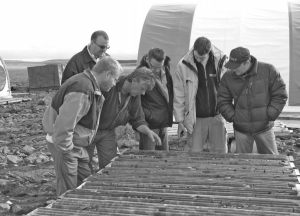Canadian Royalties (CZZ-T, CRYAF-O) is one step closer to development at its Nunavik Nickel project in Northern Quebec, now that it’s signed an impact and benefits agreement with three communities and Makivik Corp., the non-profit organization representing the Nunavik Inuit.
The agreement serves as a formal commitment by Canadian Royalties to ensure fair distribution of economic benefits from the project for the duration of the mine life.
It also ensures Inuit participation in the project through hiring and contracting locally in preference to regional Inuit supplier services. The company will also implement training programs for local job seekers.
Grant Arnold, Canadian Royalties’ vice-president of exploration, says the agreement is important and paves the way for the company going forward.
“These things aren’t easy. . . many people are unfamiliar with these issues, many see (IBA agreements) as an aside,” Arnold says. “This is a partnership with the communities –they have to be onside.”
Arnold says the company has been meeting with members of the different communities to get their input on the project.
Many people were concerned about upsetting the environment and migration patterns of animals, says Lukasy Pilurtuut, president of the Kangiqsujuaq Landholding Corp.
“The main concern was the environmental impact on the migration of caribou,” Pilurtuut says, noting that Canadian Royalties is planning an open-pit mine. “A lot (of Inuit people) would prefer underground but the potential of the ore is not deep enough.”
Pilurtuut also says communities were concerned about increased shipping traffic at the port on Deception Bay, where Xstrata (XSRAF-O, XTA-L) has been shipping ore from its Raglan nickel-copper miner for the last 10 years. The extra traffic would be a result of both Xstrata’s increased production and Canadian Royalties’ project. How the extra noise would affect seal and beluga whale hunting in the bay was the main worry.
Xstrata’s presence in Nunavik has been helpful as well, though, in coming to an agreement.
“People are more aware of the impact of a mining operation,” Arnold says. “And on the flipside, we’ve learned from Xstrata’s experience.”
One example is the dust created by trucks shipping ore, which can get on fish flesh left hanging to dry.
Arnold says this issue has been addressed by wetting the road when it’s dry and using a certain kind of asphalt.
Something that Canadian Royalties is doing differently is tailings storage. The company plans to produce paste tailings, which will be sealed in a lined tailings cell. When it’s full, the cell will be covered and permanently sealed, whereas Xs- trata uses a traditional tailings pile –“a big mountain that we can see,” Pilurtuut says.
The fact that Xstrata’s tailings are visible, however, doesn’t bother Pilurtuut personally.
“I would prefer to see it,” he says. Pilurtuut says the economic benefit from the Nunavik Nickel project is welcomed.
“We are very happy about the jobs,” he says, noting the training programs in heavy equipment operating, carpentry and prospecting.
Canadian Royalties plans to employ about 300 people during the construction phase and about 270 when the mine is in full production.
Arnold says it’s difficult to say at this point, but he expects there will be about 80 to 90 positions ensured for local people. Examples of Inuit employment include heavy equipment operators, using the local Inuit Air service and a local catering company to feed mine staff.
There are some skilled positions, such as mill operator, that require certain education that few Inuit have, Arnold says.
“For those positions you need people with diplomas,” he explains. “That’s not easy because of the high dropout rate (in Nunavik).”
Arnold says the company and the Quebec government will be encouraging local people to seek further training in places like Val d’Or.
Canadian Royalties is looking at producing 26 million lbs. nickel in concentrate, 38.8 million lbs. copper in concentrate, 900,000 lbs. cobalt in concentrate, 14,500 oz. platinum and 78,600 oz. palladium per year over nine years from the project.
The $438-million project would operate at a rate of 3,500 tonnes per day from open pits at the Mesamax, Ivakkak and Expo deposits, with some later-stage underground mining at Ivakkak, the focus of a feasibility study last year.
A recent economic assessment completed for another deposit, Mequillon, predicted the mine life could be doubled to 18 years. Capital costs to develop this deposit were estimated at $69 million up front plus $15 million in sustaining capital.
Production wouldn’t start at Mequillion until reserves at the Mesamax, Ivakkak and Expo deposits are depleted, after about nine years.
Those plans are being revised to include the Allammaq deposit, a discovery made only last August.
The company has received an initial resource estimate for Allammaq, boosting tonnage of indicated resources for the project by 11.9% and inferred resources by 12.7%.
Grant Arnold says that because Allammaq is close to the high-grade Mesamax deposit, the integration of Allammaq resources to the mine plan is now a “top priority” and that it shows potential for expansion.
“The identification of significant resources at Allammaq demonstrates that systematic exploration is the largest single creator of value for our company,” Arnold said in statement.
Indicated resources now stand at 19.4 million tonnes (up 2.1 million tonnes) grading 0.97% nickel, 1.18% copper, 0.05% cobalt, 0.14 gram gold per tonne, 0.56 gram platinum and 2.27 grams palladium.
Inferred resources are 4.1 million tonnes (up 461,000 tonnes) grading 0.96% nickel, 1.17% copper, 0.05% cobalt, 0.16 gram gold per tonne, 0.63 gram platinum and 2.45 grams palladium.
Probable reserves have remained the same — 11.3 million tonnes grading 0.97% nickel, 1.13% copper, 0.05% cobalt, 1.86 grams palladium, 0.45 gram platinum and 0.1 gram gold.


Be the first to comment on "Canadian Royalties signs IBA with Nunavik Inuit"